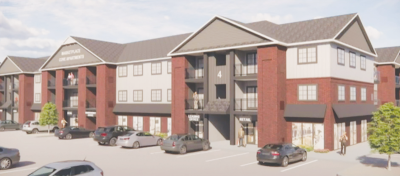
On March 19, a 4-3 majority of the Sterling Heights City Council voted to reject a proposal for the Marketplace Cove Apartments, which had been slated for Brougham Drive, near Van Dyke Avenue and 15 Mile Road.
Image provided by the city of Sterling Heights
STERLING HEIGHTS — An over three-hour discussion at the March 19 Sterling Heights City Council meeting over a proposal to put apartments along Brougham Drive ended in a 3-4 vote, causing the proposal to be rejected.
Marketplace Cove Apartments was a planned unit development proposal that involved two parcels located east of Van Dyke Avenue and north of 15 Mile Road. Two three-story buildings containing 233 apartment units with a few possible retail spaces were planned on around 6 acres at 8484 Brougham Drive. Directly to the west, a related retention pond and parking area would have sat on around 4.5 acres at 35360 Van Dyke Ave. Both parcels are zoned C-3 general business district and are within the Van Dyke Mixed Use Overlay District.
When it was time to vote, Mayor Michael Taylor, Mayor Pro Tem Liz Sierawski and Councilman Michael Radtke said yes to the project. Council members Barbara Ziarko, Deanna Koski, Maria Schmidt and Henry Yanez formed the majority to reject the plan.
A dense discussion
When the Sterling Heights Planning Commission earlier heard the Brougham proposal in November, members recommended changes to it that the developer, Tony Gallo, accepted. For instance, the proposed project used to call for 249 units and three buildings, but that was changed to 233 units and two buildings. The stipulation of trying to rent out five potential retail spaces on one building’s first floor was also added, with the possibility of those eventually becoming apartment units if no businesses leased them. In January, the Planning Commission voted 8-1 to recommend the altered proposal.
Many residents at the March 19 City Council meeting spoke out about the apartment plan during public comment, with most showing concerns over density, traffic, property values and more.
Resident Terri Gordon said she lives near the parcels and noted that the plan wouldn’t be on Van Dyke but “on a residential 25 mph street.” She also worried about overcrowding and trash spilling into her backyard.
“It’s highly dense, and there’s just too many people,” she said. “This … monstrosity is going to be the entranceway to our neighborhood. That’s what you are going to see coming into our neighborhood, and I don’t want to look at it.”
Resident Benjamin Orjada said he thought the development proposal was important because “the city’s own figures have shown that there’s a good 4,000-unit housing deficit in the city,” and he said jobs go to where housing opportunities exist. He also talked about “underhoused” people in their 20s, 30s or early 40s lacking certain economic opportunities.
“Having apartment housing options for them, having additional varieties of options in the housing market, is crucial for folks to get their foot into the door to having their own independent living situations,” he said.
Both residents and city officials continued to bring up Marketplace Cove’s density in comparison to neighboring residential areas.
There are two different ways to measure the project’s density. City officials based their preferred measurement on the estimated 6 acres where the apartments would stand, leading to a figure of over 38 units per acre. An alternative measurement takes the entire estimated 10.5 acres into account, leading to a density figure of around 23 units per acre, officials said.
City officials said that, in comparison, the densities of the surrounding residential neighborhoods are about 3.78, 6 and 10 units per acre.
Gallo said he understands that some neighbors in the area might not want change, but he said the zoned land could actually be much denser if another permitted use, such as a five- or six-story hotel, were to be built there.
“For the record, we truly believe that this is a downzoning,” Gallo said. “This is not an increase in intensity; it’s a decrease in intensity.”
During council members’ comments, Taylor supported the overall plan and pointed out the housing shortage in the area.
Taylor said the project is “pretty dense” compared to some developments in the city, but not compared to developments in other comparable metro Detroit cities.
“This is not just a community of single-family homes, and you know, going from 34 apartment complexes to 35 is not going to take us from a suburban city to an urban city,” he said.
Taylor also alluded to a recently failed apartment proposal by Sterling Square LLC. The City Council rejected that along the same 3-4 split, but shortly later the developer repurposed the land into an all-commercial plan that’s currently underway following Planning Commission approval.
“Property owners have a right to use their property, and I think a city should try to take a property and get it developed at its highest and best use,” Taylor said.
Sierawski asked Gallo for his response to potentially making the apartment buildings two stories instead of three, but he said it wouldn’t be feasible.
Ziarko said her decision to reject the plan was based on its density and the residents’ concerns.
“If you were telling me you were going to put this near Lakeside, I would say, go for it. North Van Dyke, go for it,” she said. “I’ve listened to what administration thinks is right, and I’ve also listened to what we think is right for you as a developer. But I also have to sit back and listen to what the residents brought forth tonight, that I know are their concerns, and it’s the truth.”
Learn more about Sterling Heights by visiting sterlingheights.gov or by calling (586) 446-2489.
 Publication select ▼
Publication select ▼




















